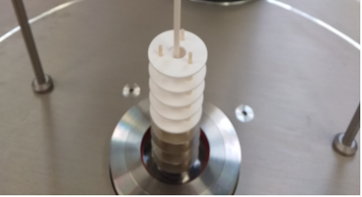Thermogravimetric Analysis (TGA)
Nano to Micro/Macro (Thermal analysis)
The analyses are performed at a maximum working temperature is 1600°C, depending on material, analysis conditions and technique (measuring head) used. The measurement is possible either in air or in specific environment (for example nitrogen).
Some application examples:
- Recording of chemical-physical transformations of the material during the heat treatment.
- Studies of oxidation resistance, reactivity, solid state synthesis, sintering, also as a function of the working atmosphere.
- Evaluation of decomposition processes, i.e. decarbonation, debonding, etc.
- Quantitative composition information of the analyzed material

@
provided at NFFA-Europe laboratories by:
Instruments datasheets
CSIC-ICMAB
Spain
TGA at CSIC-ICMAB
The simultaneous TGA-DSC/DTA analyzer NETZSCH STA 449 F1 Jupiter allows the measurement of weight and DSC (heat flow)/DTA (differential thermal analysis) signals as a function of temperature and time. It is used for monitoring chemical reactions, thermal stabilities, solvent evaporation and reduction and oxidation of materials under different gases among other studies. The sensitivity of the balance is 0.07 micrograms. The furnace can operate from room temperature to 1400 C. The analyzer may work in several atmospheres such as oxygen, air, argon and hydrogen (diluted at 5% in Ar), at ambient pressure and with using typical flow rates of 70 cm3/min.

@
provided at NFFA-Europe laboratories by:
Also consider
Structural & Morphology Characterization
SEM Scanning Electron Microscopy
In SEM a beam is scanned over a sample surface while a signal from secondary or back-scattered electrons is recorded. SEM is used to image an area of the sample with nanometric resolution, and also to measure its composition, crystallographic phase distribution and local texture.
Structural & Morphology Characterization
XRD X-Ray Diffraction
XRD provides non-destructive information on the structural order of a material. At large scattering angles XRD permits to identify different crystal phases and to quantify lattice distances and crystalline volume fractions. At low angles of incidence the surface roughness of a single crystal and the thickness of a deposition layer can be obtained.
Nano to Micro/Macro
DSC Differential Scanning Calorimetry (DSC)
Differential Scanning Calorimetry (DSC) measures the difference in the amount of heat required to increase the temperature of a sample and reference as a function of temperature and therefore considers its energetic variation.
Electronic & Chemical & Magnetic Characterization
XPS X-ray Photoelectron Spectroscopy
XPS is a surface spectroscopic technique for quantitative measurements of the elemental composition or stoichiometry and the chemical state of the present elements, like their oxidation state and chemical bonds. XPS is highly surface sensitive, giving chemical and binding energy information from the a narrow region close to the surface.
Structural & Morphology Characterization
TEM Transmission Electron Microscopy
In TEM/Scanning TEM (STEM) high energy electrons incident on ultra-thin samples, allow imaging, diffraction, electron energy loss spectroscopy and chemical analysis of solid materials with a spatial resolution on the order of 1-2 Å. Samples must have a thickness of a few tens of nanometres and are prepared in sample preparation laboratory.





